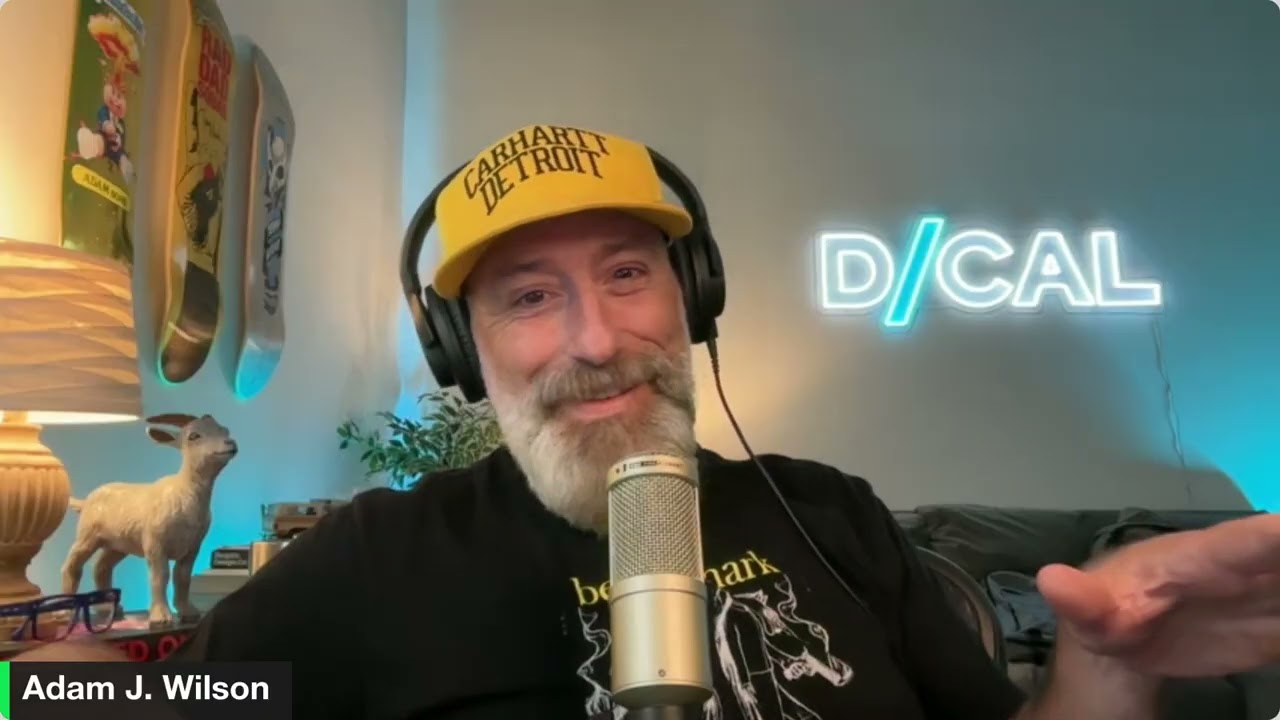Adam J. Wilson, Co-founder of D/CAL, spent years watching brands throw billions at data while their CMOs kept getting fired. The former Carhartt brand marketing leader saw the pattern clearly: massive data sets, squeezed through algorithms, producing insights that were technically true but not true enough.
So he built an agency that does the opposite.
D/CAL’s approach—the “sub method”—starts by ignoring lawn care when you’re selling grass seed. Instead, they find the yoga enthusiasts, the DIY obsessives, the suburban parents who gather in Reddit’s corners. Then they actually talk to them. Six conversations later, they know more about a growth segment than $60 billion in third-party data ever revealed.
“We learned more about this growth segment than they knew before by virtue of literally spending really good time with six people,” Wilson explains. The insight that changed everything for Scott’s newest brand? These customers don’t call it a lawn. They call it a yard. And that distinction unlocked an entirely different marketing strategy.

The $60 Billion Data Problem
Wilson’s perspective comes from living both sides of the agency-client relationship. His time at Carhartt taught him massive empathy for brand leaders trying to balance internal teams, outside agencies and the crushing pressure to justify data investments.
“The pendulum has swung so hard toward everything being very data driven,” Wilson says. Fortune 1000 companies have spent roughly $60 billion on third-party data over the past decade—and that’s before counting first-party data investments. “The problem is we’re just over reliant on quantitative driven insights. They end up being averages.”
Those averages create a dangerous illusion of certainty. CEOs and CFOs look at CMOs and wonder why they can’t deliver breakthrough work when they have what looks like a crystal ball. But according to Cannes Lions’ creativity report, 51% of brand leaders admit their insights are too weak to drive breakthrough creative.
“What clients really want is to play with confidence,” Wilson says. “And the way to play with confidence is to have a differentiated insight and brief.”
Everyone’s Fishing From the Same River
When every brand uses the same massive data sets, their briefs start looking remarkably similar. Then everyone wonders why differentiated work feels impossible to create.
Wilson flips the familiar creative review question back on brand leaders: “How is this creative idea ownable? Could your competitor do or say the same thing?” becomes “How is your understanding of your audience ownable and differentiated? How are your insights and your resulting brief different than your competitors?”
The answer, he’s found, lives in subcultures—what Wilson calls “a Bougie way of saying the things people are really interested in, things they spend discretionary time and money on.”
How the Sub Method Actually Works
D/CAL starts with a client’s existing segmentation. They don’t throw away the quantitative work. They enhance it by going narrow when everyone else goes wide.
First, they identify the most active subcultures within the target segment. For Scott’s growth audience, that meant DIY home ownership, clean eating, yoga and suburban parenting communities. Then they double-click to find the most vocal members—someone moderating a subreddit with four or 5,000 engaged participants.
Here’s the crucial part: they don’t ask these people about the product category. They ask about yoga. Or DIY projects. Or whatever drives that person’s passion.
“If you sat down at a dinner table and you started asking people about the things they’re truly interested in, the conversation is going to go somewhere,” Wilson explains. “If you start talking to them about their household income and vacation, I know we’ve just met, however, I’d like to know your household income.”
The method is “unapologetically narrow and qualitative.” When a search consultant questioned whether going too narrow would work for a mass marketer, Wilson’s response was direct: “That’s the point. That is the absolute point. Because everyone’s going so wide.”
What Six Conversations Revealed
For Scott’s, those six conversations uncovered a critical blind spot in their otherwise excellent segmentation. The target audience didn’t refer to their outdoor space as a lawn—they called it a yard. And the more D/CAL dug into that distinction, the more they understood these were fundamentally different people with different motivations.
“We didn’t start talking to them about lawn care,” Wilson says. “We go find the most passionate, the most vocal, and we go tap them on the shoulder.”
The insights kept coming. These weren’t the neighbors who’d panic over a Slip ‘N Slide yellowing the grass. They were parents who saw the bald dirt patch under the tree swing as evidence they were parenting the right way. Their kids were outside playing.
That insight unlocked a completely new creative approach—celebrating the messy reality of having a yard, not maintaining a perfect lawn. It let Scott’s build a brand around actual human behavior instead of idealized lawn care fantasies.
The Cultural Advisory Board Difference
D/CAL backs up their subculture obsession with structure. Their Cultural Advisory Board includes seven people who’ve never worked at an agency—including co-founder and legendary skateboarder Tony Hawk, Grammy winner Paul Blair, women’s advocate Jessica Murnane and streetwear expert Rick Williams.
“They’re way cooler than the rest of us, but don’t have the bad habits of working at agencies,” Wilson says. They serve as creatives, composers, strategists and—most importantly—bullshit detectors. They keep D/CAL close to creator culture and honest about what actually resonates.
All seven hold equity in the agency. They do their own thing—Hawk stars in other people’s work, Blair produces music across the industry—but they bring credibility to throwing around the word “subculture” and represent the tippy top of a robust network that understands the attention economy.
Beyond Demographics to Actual Humans
Wilson’s crusade isn’t against data. It’s against the over-reliance on quantitative insights that flatten human complexity into demographic averages. He points to his own experience as proof: at 52, he finally bought the Subaru WRX he always wanted. Now he’s in forums with everyone from 17-year-olds to 60-year-olds, all backgrounds, all education levels.
“Our interest transcends those demographics,” he explains. “And people get really talkative and will volunteer a lot of information.”
The video journaling and conversations reveal everything from what’s in people’s pantries to what’s in their driveways—a high-fidelity picture that goes far beyond demographic checkboxes.
Four Weeks to Brief Optimization
D/CAL typically needs four to six weeks to run the sub method before briefing. In a go-to-market cycle that might span 18-20 months (80 weeks), asking for four weeks to ensure the brief is “dripping with truthiness” isn’t much.
“It’s not much to ask in that span,” Wilson says. “Let’s just make sure the brief is well.” That allows brand leaders to play with confidence—and they don’t have to tell the CEO that the real insight came from “actually talking to some fucking people” instead of the expensive data warehouse.
The work speaks for itself. Scott’s clients now walk those halls with their heads held high, Wilson reports, because they’re doing things they couldn’t do before—like showing kids jumping on oversaturated turf or celebrating the yellow spot the trampoline leaves behind. In their world, that was unheard of.
The Confidence Question
Wilson’s time on the brand side gave him permanent empathy for marketing leaders under siege. The entire marketing vertical is being de-platformed, threatened by everything from AI to the staggering complexity of the modern marketing ecosystem.
“We just need to find more ways to allow them to play with confidence,” he says. “Most of them want to. Most of them understand the power of creative, and most of them understand that the most powerful creative comes from a very succinct, cogent, very real insight.”
They’re just not getting those insights through the averages. And if agencies don’t help brand leaders play with confidence, Wilson notes, “we’re not going to have anyone to hire us.”
Advice for Agencies Stuck on the Data Treadmill
For independent agencies watching this and recognizing their own creative rut, Wilson’s prescription is straightforward: help brand leaders get off the treadmill. If you have the relationship—and you should have the relationship—you can push back on the brief and what the client believes the insight really is.
“People live and what their interests are is where you’re going to find the best insights to build work around,” Wilson says. “And that transcends demographics.”
The investment isn’t huge. The payoff is differentiated briefs that lead to ownable creative that competitors can’t replicate. Because while everyone else is fishing from the same river of data, you’re having dinner table conversations with actual humans who want to tell you about the things they love.
As Wilson puts it: “We could do a whole other episode on my belief that the middle of the funnel should just be removed completely. Just focus on the top and focus on the bottom.”
But that’s a conversation for another day.
Learn more
D/CAL
Adam J. Wilson LinkedIn
D/CAL LinkedIn
Contact: ad**@********cy.com
What did you think of this content?
Click on the smiley faces to rate it!
Average rating 0 / 5. Vote count: 0
No votes so far! Be the first to rate this post.
We are sorry that this content was not useful for you!
Let us improve!
Tell us how we can improve our content?



